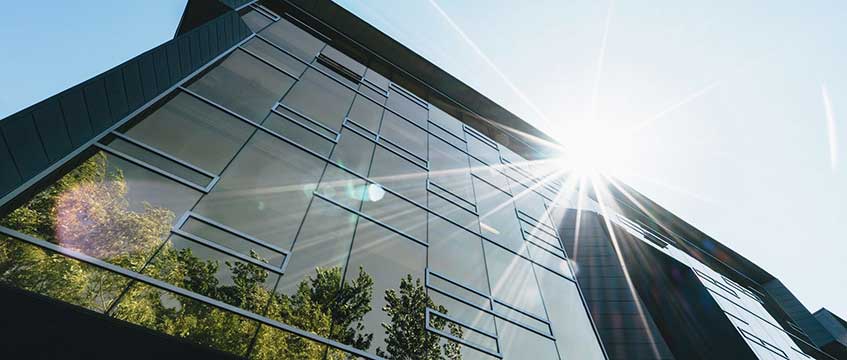The pandemic’s upending of norms is likely to drive a fundamental change in how we live and work. Some companies are already taking a strong stance on the long-term viability of remote working at scale, and developers are considering what a healthy home/workplace of the future may look like. Despite uncertainty for office owners and occupiers, this rapidly emerging new world also presents a significant opportunity.
Office occupiers report that they ‘can operate without an office but…’
Working remotely and operating facilities with minimum services to maintain business continuity is possible and sustainable, but has placed some stress on individual and business performance. JLL envisages offices will remain a crucial hub for enterprise; a place to learn, socialise and connect, with desk-based work more likely to be remote. Organisations will embrace strategic changes to their portfolios and repurpose existing space to ensure that they put their greatest asset – their people – first. JLL also expects smart organisations to double down on measures that support employees’ health, wellbeing and productivity, whether that be in the office or at home.
Designing and measuring wellbeing and productivity in the workplace
Office buildings should be able to measure and demonstrate health and wellbeing benefits and outcomes in the same way the industry can measure and demonstrate environmental benefits and outcomes. In this future, a landlord can confidently market its building’s wellbeing benefits, and the corporate tenant and its employees can experience a positive impact based on choosing that building. As a rough rule of thumb, improving employee productivity by 5% easily covers a company’s real estate costs.
WELL Building Standard, Fitwel, RESET, or another bespoke approach with KPIs can assess and benchmark key facets of spaces and operations: air quality, lighting, acoustics, biophilic design, activity levels and even social programmes. They force occupiers to gather evidence and hold strategic conversations on where to invest to maximise value: bricks and mortar, employee support or community programmes? All investment should improve the wellbeing of building users and communicate outcomes.
Demonstrating wellbeing performance in operation
The right performance metrics and technology solutions will be critical to respond to the demand for healthy buildings. One particularly relevant metric currently is air quality, which strongly affects productivity. Air quality is now also linked to Covid-19 safety. Buildings which can demonstrate good indoor air quality will be in high demand going forward.
RESET – a performance-based air quality standard for commercial buildings – is likely to see higher adoption. Similarly to WELL, RESET requires regular testing to demonstrate air quality standards are met. Regular measurement of actual performance is a big shift from building standards’ historical design-focused approach. There are currently only 42 RESET-certified sites worldwide. The first European RESET-certified Core + Shell office is at 33 Glasshouse Street in London, and receives very positive feedback from its three large tenants.
Why measuring air quality matters
Initial research from the US found a direct link between outdoor air quality and the increase in the death rate from Covid-19. Offering cleaner air at work could be perceived as a real benefit by employees and employers who are anxious about complications from Covid-19 infections.
Viruses can also spread faster in low-humidity environments. Research shows that maintaining a humidity level between 40% and 60% is effective in lowering infective aerosolised viruses and optimises the ability of our immune system to fight viral and bacterial infections. WELL and RESET-certified projects normally have humidity monitoring built in and will be in a better position to manage humidity levels than office spaces with no monitoring.
Finally, higher ventilation rates are associated with decreased disease spread as well as improved cognitive function. WELL projects must comply with selected international standards on ventilation and can get extra points by increasing outdoor air supply rates. RESET projects are likely to have good ventilation in order to deliver on their air quality targets and these are monitored. Fitwel offices may have indoor air quality policies and testing as part of their certification.
Technology will be a force for good
The role of technology and automation is of particular interest now to support healthy workplaces (including home offices), improve efficiencies and remove unnecessary risks. There is a wide landscape of tech suppliers offering remote monitoring and all manner of sensors to track operational functionality and performance. Vergesense and Awair sensors are just two of the examples of products we have installed in JLL’s offices to track space usage and indoor environmental quality respectively. Rapid, reliable digital connections are fundamental for both productivity and mental wellbeing; JLL predicts that as remote working expands, digital infrastructure standards will become part of companies’ wellbeing strategies for the new era of distributed offices.
What’s next for you?
The pandemic has sped up workplace and work culture changes that were already under way. Now that we are adapting to a new normal, it’s time to put our minds to the task of truly optimising the new working environments and cultures that we are settling into.
Understanding what people need to thrive and produce their best work should now become the norm across workspaces for decision-makers. Tech will also allow us greater personalisation and monitoring of our spaces in real time, allowing these to adapt to immediate needs.
We have the opportunity of a wholesale reset in office design and operations, and I would urge those working in design and fit-out, and those funding the decisions, to be bold, set new standards by implementing what we know actually works for us, and measure and share the results for all to learn from.
Lora Brill is an associate and Beth Ambrose is a director at Upstream Sustainability Services, JLL








